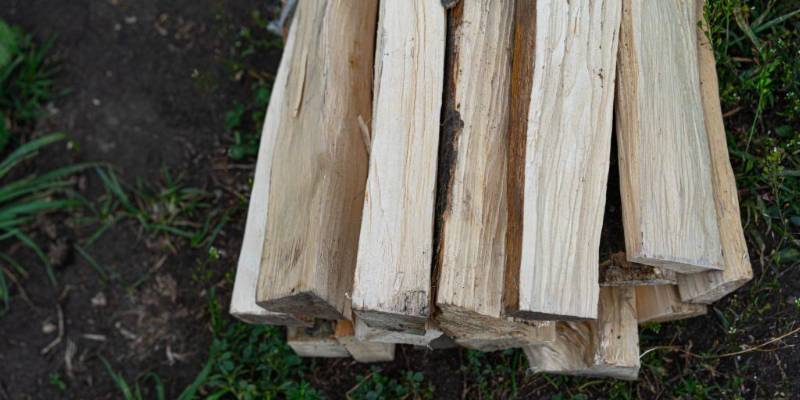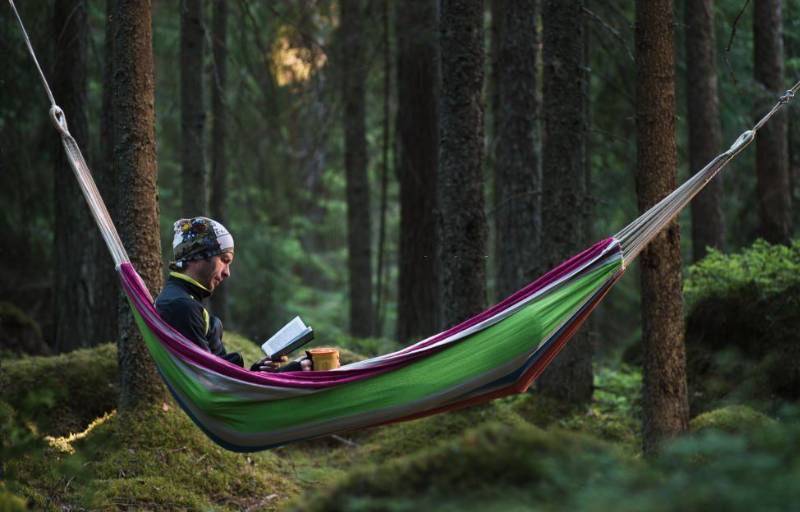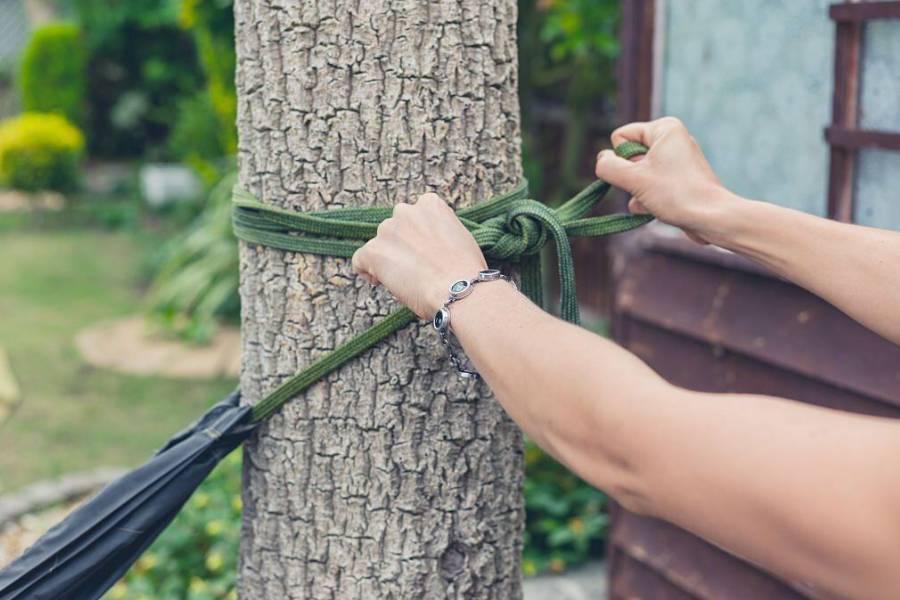How to Survive in the Forest
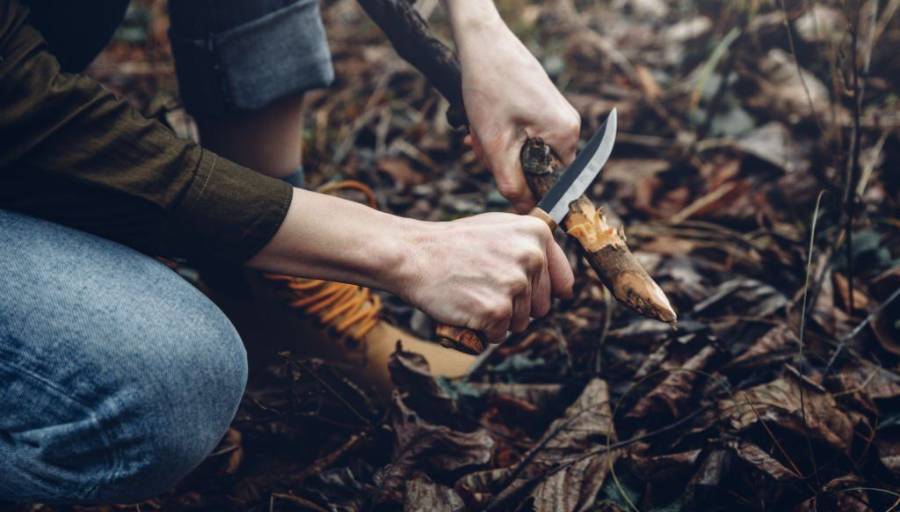
Compared to bushcraft, which is a deliberately chosen way of life, survival is an experienced event. It appears necessary when you break a leg during a hike in the forest. It can also happen that the nature outing is prolonged and that you get lost after a while.
In these conditions, we must deal with the most urgent without giving in to panic. With a few key gestures, you will be able to find bearings and satisfy basic needs. From the construction of a shelter to the recognition of edible plants, let’s see how to survive in the forest and find your way.
Prepare for the Most Urgent: Injuries
One of the reasons you might find yourself having to survive in the forest is when an accident happens. You could fall into a ditch and break your leg. The first point of survival in the forest is therefore to protect yourself. Even in the middle of the forest, there is a solution to make a splint and thus protect your broken arm or leg:
- Find a wooden stick that will serve as a support for the splint
- Place it behind your leg to prevent it from folding over
- Secure the stick securely with strings, if you have them, or your shoelaces if you don’t.
Get Your Bearings
Getting lost in an unfamiliar place, such as a forest, or sustaining an injury can be psychologically challenging. It is natural to panic when you lose your bearings. But there are also simple solutions to put in place to find reliable landmarks. This will allow you to reduce anxiety and regain your sanity so you can complete the next steps.
Mastering the Notion of Time
You didn’t bring a watch because you thought the hike wouldn’t last forever or maybe it broke when you fell. Don’t panic, there is a way to determine the approximate time.
Start to find a place where you can see the horizon and the sun. Then, come and place your hands between the horizon and the sun as in Figure 1 (below). Each finger height represents a quarter of an hour. With this method, you will know how long the sun will set with an accuracy of a quarter of an hour. Of course, if the sun is high in the sky, you have more than 2 hours left!
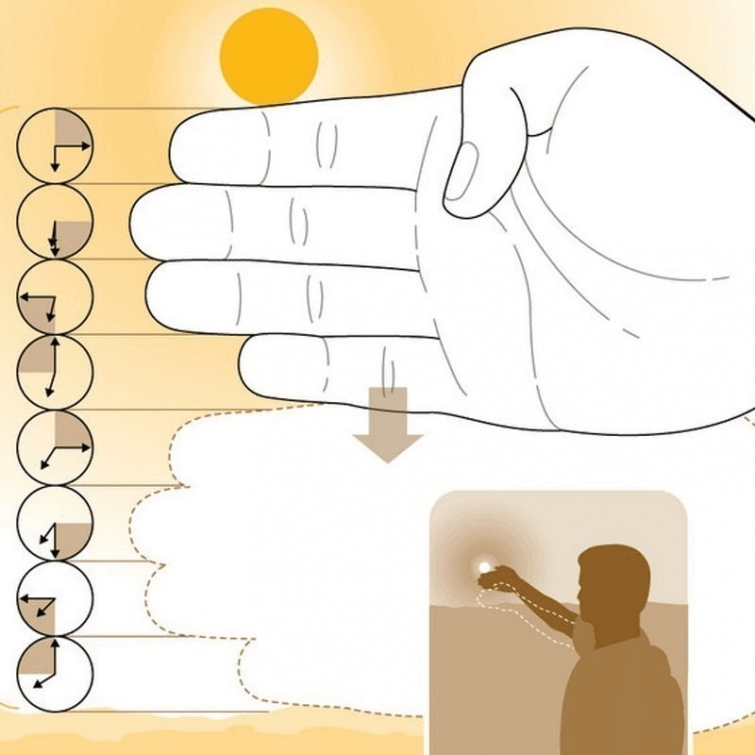
Determine Your Position During the Day
Now that you know how many hours you have left before the sun sets, you can use that time to determine your location as accurately as possible. Along with the position of the sun in the sky, you also get the 4 cardinal points. If it’s close to the setting, you know it’s pointing west. All you have to do is deduce the other axes: the opposite is the east, etc.
Meet Up At Night
Two clues will help you find your position during the night if the sky is clear; the stars and the Moon. Do you know the constellations of the Big Dipper (big pot) and the Little Dipper (little pot)?
Concerning the Moon, its time of appearance can provide you with information about the cardinal points. If it becomes visible before sunset, the illuminated part is oriented toward the west. Conversely, if it appears after midnight, it faces east.
Essential Survival Activities
Now that you have the basic data to locate yourself geographically and in time, you will be able to concentrate on the shelter to spend the night in the best possible conditions. The agenda includes tasks such as searching for or constructing a shelter, seeking out food sources, and locating drinking water.
Find or Build a Shelter
Now that you’ve figured out how much time you have before dark, you’ll need to start by finding shelter. This will allow you to protect yourself against the temperatures. This can be low at night but also against the humidity of the forest, and above all against the vagaries of the weather.
If you are in the mountains or a hilly area, it is sometimes possible to find a rock shelter or even the entrance to a cave. The advantages of these shelters are multiple:
- You save valuable time by not having to build the shelter
- Temperatures are stable, around 12°C, which can save you from hypothermia
- There is often fresh water within the caves
- You will be sheltered from rain or snow
However, if finding such a shelter is impossible or proves fruitless, it is always possible to build one yourself. For this practice, the search for a favorable and protected ground is essential. Then think of a flat area, sheltered from the wind as much as possible, close to a river if you can.
Do not build this shelter near a river. Because in the event of flooding, it could be dangerous for you. In the forest, the simplest and fastest shelter to build remains the plant shelter as in Figure 2 below.
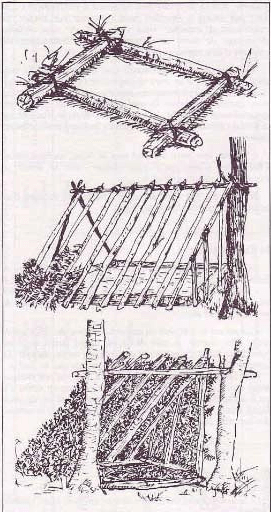
To design this plant shelter, all you need is a survival knife to cut the necessary branches as well as branches. As you will notice in Figure 2, a horizontal branch serves as the ridge purlin of your shelter.
Then place several vertical branches planted in the ground that will support the waterproofing layer. Then collect lots of large branches, patches of bark, and leaves to create an impermeable layer.
To gain comfort, you can put fir branches on the ground because they do not absorb humidity. This will decrease the feeling of cold during the night due to ambient humidity.
Find Water and Make It Drinkable
Water is one of the most important things for survival. Without it, a human being only survives 3 days on average. This decreases to barely 24 hours when the ambient temperature exceeds 40°C. As you have understood, finding drinking water will be one of your priorities.
In the forest, it is possible to collect rainwater using the leaves of the trees which act as a rainwater harvester. However, it will not necessarily rain during this survival experience, and knowing how to filter the water from the water points will be necessary.
Remember that crystal-clear water is not synonymous with drinking water! Water from rivers, lakes, or streams should be filtered as best as possible before drinking. Even without filtration equipment, there are methods to achieve a satisfactory result in the forest.
If you have already started a fire in your shelter and you have a container, you will only need to boil the water. This kills the bacteria responsible for the health problems you may experience from drinking unfiltered water. Otherwise, another solution is possible, the filter:
- Take a piece of cotton fabric like a T-shirt
- Place it horizontally then pour crushed charcoal on it
- Add sand and then coarser gravel
- Pour the water through this homemade filter
If you have the opportunity, combine these two methods to get rid of pollutants and bacteria in the water.
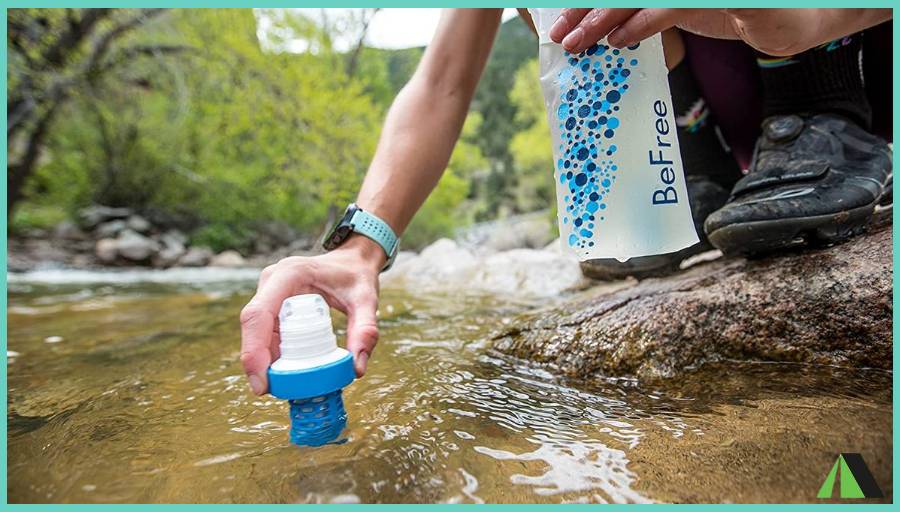
The Search for Food
Although you can go about 3 weeks without eating under normal conditions, foraging will still be one of your priorities during survival. There are two possibilities for this: hunting and gathering, as for prehistoric men!
The Laying of Snares
Snaring will allow you to catch prey such as rabbits and hares. For this, you will need a piece of wire and two sticks, as in Figure 3, below. Make a ring at the end of the wire then pass the other end through this ring. This will have the effect of creating a slipknot that will ensnare the prey when it tries to pass through.
Come and fix the collar as in the figure below then wait for the animal to bite the bait! If you can, set multiple snares to increase the chances of capture. Finally, check frequently that they have worked, otherwise, your prey will be eaten by those bigger than it!
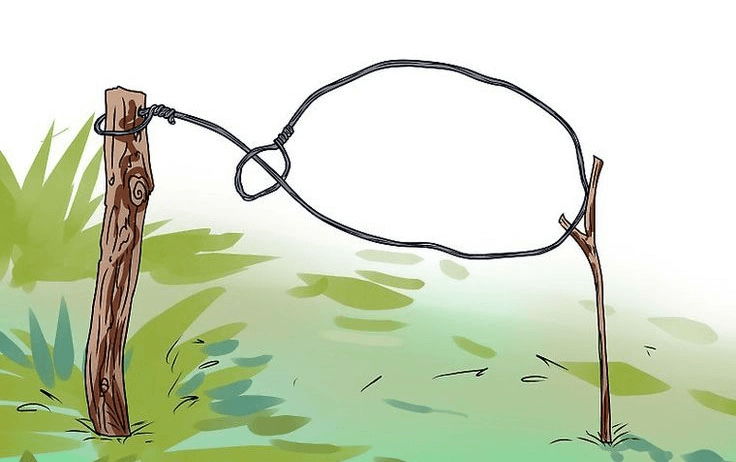
Method for Finding Edible Berries
Don’t want to kill animals or eat meat? This is not a problem since there is a solution for finding berries and knowing which ones are edible. If you know mushrooms well, you can even apply your knowledge of the subject to recognize them in the forest!
But back to berries, their color is absolutely not a reliable way to know if they are good or bad for your health. The green ones can sometimes be poisonous and the red ones can be edible depending on the variety on the contrary. To be certain, here are 4 essential steps to put into practice when you discover berries in the forest:
- Press one or more on your skin to see if an allergy appears
- If there is no reaction after 10 minutes, repeat the same operation but, this time, on your lips
- Still not seeing anything? It’s not over, put one in your mouth, and chew it for about ten minutes again but without swallowing it!
- If you don’t feel itchy or have heartburn or any other warning signs of poison, you can eat a small amount. Wait a few hours, then if nothing happens again, the berry seems edible
Belladonna may look very appetizing but it is actually a poison. Its nicknames speak for it: devil’s weed, poisonous, poisonous cherry… Always take precautions when dealing with wild berries. This can be fatal in adults after 15 berries are ingested and in children after 5 berries.
Techniques for Starting a Fire
Do you have a Firestone? But, if you don’t have any tools to light a fire, you still have an equally effective solution: the arc of fire (see Figure 4, below). To create it, you need very few things: a rope and a piece of wood bent in the shape of an arc, from which it takes its name.
As with firesteel, make a small pile of dry wood chips or tinder fibers to use as fuel and as a starting point for your fire. Place this mound in a hole in a wooden board, as in Figure 4.
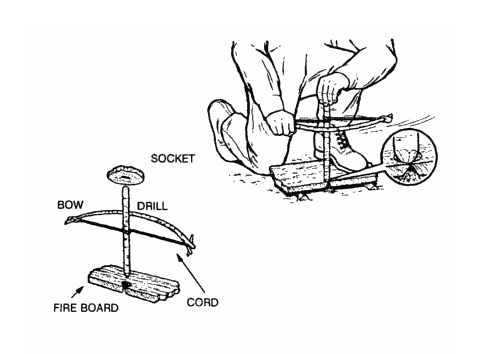
Finally, move the arc from right to left to create a rotation of the vertical piece of wood. This rotation will heat the wood which will then produce the heat needed to start the fire. Then manage the number of wood chips to control your fire.
Finding Your Way Home
After you have solved the problem of basic needs and after you have resumed a deserved rest, it is now time to find your way as soon as the sun rises. If you have an IGN map of the surroundings, you can take a look at our article on how to prepare and organize a hike!
There is a simple solution: follow the bed of a river, this will necessarily lead you to a house or a village.
Conclusion
Survival is therefore the result of a loss of your points of reference or an accident occurring during a hike. Even in the event of an injury, it is possible to make a custom-made splint with the means at hand. Even better, a forest has everything you need to build shelter and find food and water. You can take advantage of the wood to make a fire or shelter for one night, you can also filter the water from the rivers and lakes to make it drinkable.
With the snare technique, you will be able to catch and then eat a rabbit. During survival, you will also be able to recognize edible berries or non-edible thanks to the 4 key steps. Finally, simple techniques to implement will allow you to know the time and your geographical position to find your way.
Are you ready to survive in the forest?

